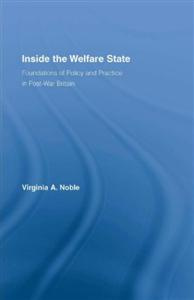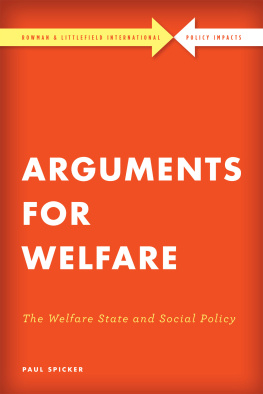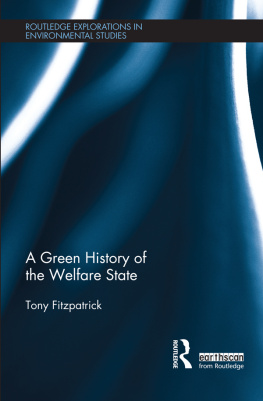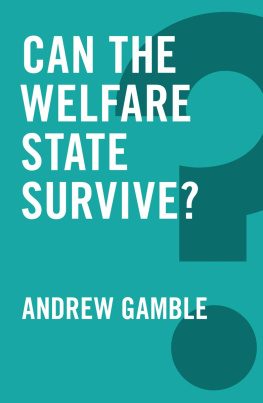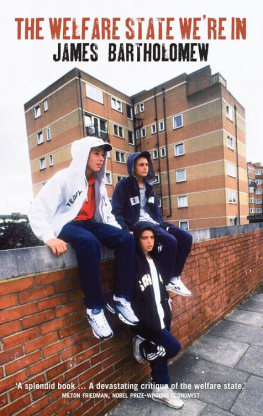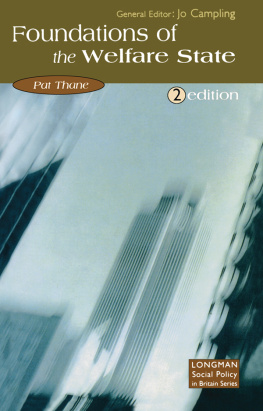Inside the Welfare State
Foundations of Policy and Practice in Post-War Britain
Virginia A. Noble

First published 2009 by Routledge
270 Madison Ave, New York, NY 10016
Simultaneously published in the UK by Routledge
2 Park Square, Milton Park, Abingdon, Oxon OX14 4RN
This edition published in the Taylor & Francis e-Library, 2008.
To purchase your own copy of this or any of Taylor & Francis or Routledges collection of thousands of eBooks please go to www.eBookstore.tandf.co.uk.
Routledge is an imprint of the Taylor & Francis Group, an informa business 2009 Virginia Noble
All rights reserved. No part of this book may be reprinted or reproduced or utilised in any form or by any electronic, mechanical, or other means, now known or hereafter invented, including photocopying and recording, or in any information storage or retrieval system, without permission in writing from the publishers.
Trademark Notice: Product or corporate names may be trademarks or registered trademarks, and are used only for identification and explanation without intent to infringe.
Library of Congress Cataloging in Publication Data
Noble, Virginia A., 1963-
Inside the welfare state : foundations of policy and practice in post-war Britain / Virginia A. Noble. 1st ed.
p. cm. (British politics and society)
Includes bibliographical references and index.
1. Public welfare Great BritainHistory 20th century. 2. Great Britain Social policy. I. Title.
HV245.N67 2008 361.6'5094109044 dc22 2008021723
ISBN 0-203-88731-X Master e-book ISBN
ISBN10: 0-415-70187-2 (hbk)
ISBN10: 0-203-88731-X (ebk)
ISBN13: 978-0-415-70187-7 (hbk) ISBN13: 978-0-203-88731-8 (ebk)
3 Reform and Deterrence
The National Assistance Boards Strategies for Unemployed Men
In the 1950s and 1960s, the specter of unsupported families living off the public purse was a source of perpetual anxiety for officials at all levels of the British National Assistance Board (NAB, or Board). The NAB devoted considerable time and attention to the increasingly arduous task of encouraging and coercing lone women to turn to men, rather than the state, for economic support. The premise of this approach, of course, was that men were willing and able to sustain their families by wage-earning. What good were policies encouraging womens dependence if men themselves had no qualms about seeking public assistance? To deter men from claiming national assistance, which had replaced poor relief in 1948, the NAB developed complicated machinery to reinforce a norm of masculinity centered on male breadwinning and autonomy. Well-publicized programs to correct and reform unemployed men on the national assistance rolls became part and parcel of the NABs program, as important as its payment of cash allowances. Despite the oft-repeated public renunciations of the punitive and stigmatizing features of the old Poor Law, the NABs strategies to shore up masculinity owed much to the disciplinary aspects of poor relief that had, in theory, been discarded once and for all after the Second World War. The rationales of the workhouse persisted in NAB policy, as did the use of communal sanctions to reprimand the morally deficient. But in its project to reform and discipline unemployed men, the NAB could also draw on the assets of the modern bureaucracy, including specialization within its own ranks and medical and vocational expertise from other agencies. In the 1950s and 1960s, the practices of both the old and new worlds of welfare converged; the result was a mixture of disparate methods that ultimately functioned more effectively in dissuading men from seeking assistance than in reforming them.
In the literature on the British post-war welfare state, scholars generally focus on the last quarter of the twentieth century, rather than the 1950s and early 1960s, when discussing significant governmental scrutiny and criticism of unemployed men receiving public assistance. Alan Deacon argues that when unemployment rates rose dramatically in the late 1960s and 1970s, widespread press coverage of alleged fraud and abuse inflamed public hostility toward the unemployed. The resulting scroungerphobia, he contends, prompted officials to introduce several measures to detect and deter malingering.1 Chris Jones and Tony Novak detail the backlash against the unemployed under Thatcherism, which included benefit reductions, stigmatization, and efforts to monitor the behavior and appearance of claimants.2 The literature pays scant attention to the NABs views of unemployed men before the late 1960s, characterizing the period as one of quiet obscurity, 3 during which officials did not concern themselves with malingering or scrounging. 4 However, an examination of the NABs policies and practices in its early years belies this picture of complacency. Instead, the evidence indicates that officials, who were intensely concerned about unemployed men claiming assistance, developed elaborate mechanisms for moving them off the rolls. By the early 1950s, the drive to cut the number of unemployed applicants had begun; an undertaking that gradually pulled together various threads of the modern bureaucratic state.
Various narratives emerged in the NABs explanations of its mission, narratives that featured the state as a benevolent, guiding hand enabling a transition from idleness to productivity, or alternately, as a stern taskmaster refusing to subsidize laziness. These straightforward morality tales imposed order and meaning on a far more complicated social and administrative reality. The causes of prolonged male unemploymentoften involving mental and physical disabilitywere complex, and the NABs tools were often ill-suited for the task of getting men into sustainable work. Yet, the simplified representations produced by the NABfor its own self-definition, for the edification of its claimants, and for broader public consumptionplayed a large role in forming prevailing cultural beliefs about what welfare was and what it should be. In NAB narratives, mens reliance on assistance signaled a failure of masculinity. Proper manhood, fostered by NAB programs, would result in self-sufficiency and obviate the need for state support. In practice, however, the deterrent effect of the governments methods for instilling manliness overshadowed their rehabilitative achievements. In the 1950s and 1960s, thousands of men left the national assistance rolls to avoid the various sorts of reform dispensed by the NAB. To NAB officials, this outcome was just as acceptable as successful rehabilitation; in the end, the measure of appropriate masculinity was abstinence from national assistance.
National assistance, like the Poor Law it succeeded in 1948, was a means-tested program. Only those with income and resources below certain levels were eligible for allowances. Many recipients of national assistance also received national insurance benefiteither old-age pensions, unemployment benefit, or sickness benefit. They were entitled to national insurance benefit by virtue of their payroll contributions to the National Insurance Fund, but national insurance alone was not sufficient for subsistence. For many people, national assistance topped up their national insurance payment. An unemployed man, therefore, might receive unemployment benefit and an assistance allowance. But unemployment benefit could only be paid for six months; once this was exhausted, he was entirely dependent on national assistance. Also, for men who did not have stable work histories, unemployment benefit through national insurance was not available since they had not made enough contributions to the National Insurance Fund. They, too, were completely reliant on national assistance.
Next page
